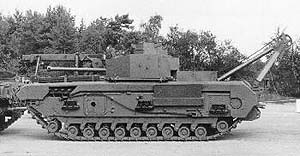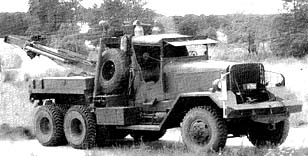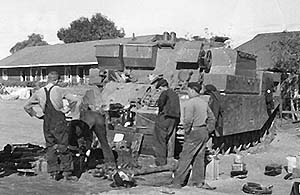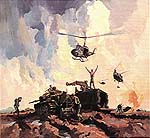
1st Armoured Regiment LAD
Centurion Tank Recovery in the early 1950s
I joined the Army in 1952 and was allocated to RAEME. being posted to Moorebank Workshop, Sydney to work on Matilda tanks before doing a Recovery Mechanic's trade course at the RAEME Training Centre, Ingleburn with Clive Cook. I joined the Regiment's LAD in late 1953 as a Recovery Mechanic —— two years after the Centurion Gun tank went into service with the Regiment.
When I arrived at the LAD the heaviest Recovery Equipment in Army inventory was the Churchill Armoured Recovery Vehicle and the M1A1 Ward LaFrance Recovery Vehicle (Wheeled)

| Length | 8.38 m (27 ft 6 in) |
| Width | 3.04 m (10 ft) |
| Height | 2.96 m (9 ft 9 in) |
| Weight | 40 tons |
| Winch | 25 tons capacity |
| Engine | Bedford horizontally opposed 12 cylinder petrol |

| Length | 7.92 m (26 ft 6 in) |
| Width | 2.51 m (8 ft 3 in) |
| Height | 3.10 m (10 ft 2 in) |
| Wheelbase | 4.57 m (15 ft 1 in) |
| Front Winch | Capacity — 13ton(us) .. 11.6ton(imper) |
| Rear Winch | Capacity — 22ton(us) .. 19.6ton(imper) |
| Crane | Max Lift — 9¾(us)tons .. 8¾(imper)ton |
| Engine | Continental 8.2 litre 6 cylinder petrol |
The Ward LaFrance was a most unlikely vehicle to use to recover a centurion tank. Whilst posted at Moorebank Workshop we had a Recovery Team standing by and one Operator was on 24 hour duty, 7 days a week roster system. N Squadron, comprising centurion tanks was moving into the Holdsworthy area and managed to bog a centurion in a creek. We were called to recover it and only had at our disposal a Ward LaFrance Wrecker that provides a 12ton rear winch [See comment above] ; a bit awkward to recover a 52ton centurion bogged in a creek up to the sponsons so it was possible to step straight onto the hull without climbing up. Our major problem was the lack of heavy duty snatch blocks and ropes to connect to the bogged vehicle. Staghound tow ropes saved the day. 2½ days later the bogged centurion was out.

At Puckapunyal we used a Churchill ARV that Cpl Joe Harlow had got into running order. This vehicle was under-powered for the job and had a major problem sucking in the Pucka dust
In 1954 a Centurion Gun Tank was made available to us. This Centurion, 169041, had been a target vehicle used for the 1953 Atomic Tests.
Two Centurion Armoured Recovery Vehicles arrived from the U.K. in 1955, making our tasks a lot easier. In true Army style somebody had to sign for them and be responsible for their use and maintenance. I took possession of both ARVs and used one for recovery duties as required. Bringing the ARVs to charge involved laying out on a tarp all the pieces carried by the ARV. The photo shows me bent over identifying bits and pieces for the Q. This drew interest from various personnel, hence the gathering of some mechanical types

Taking CES inventory (loose items belonging to the ARV)
Stan Tilley, Ron Bond (rear view), Sid Olinski and Archie McDonald
Not shown.. Ron Vaughan
| Length | 8.87 m (29 ft 9 in) |
| Width | 3.39 m (11 ft 11½ in) |
| Height | 2.83 m (9 ft 6 in) |
| Weight | 45 tons |
| Winch | 30 tons capacity - direct pull |
| Engine | Rolls Royce designed Meteor 12 cylinder petrol |


